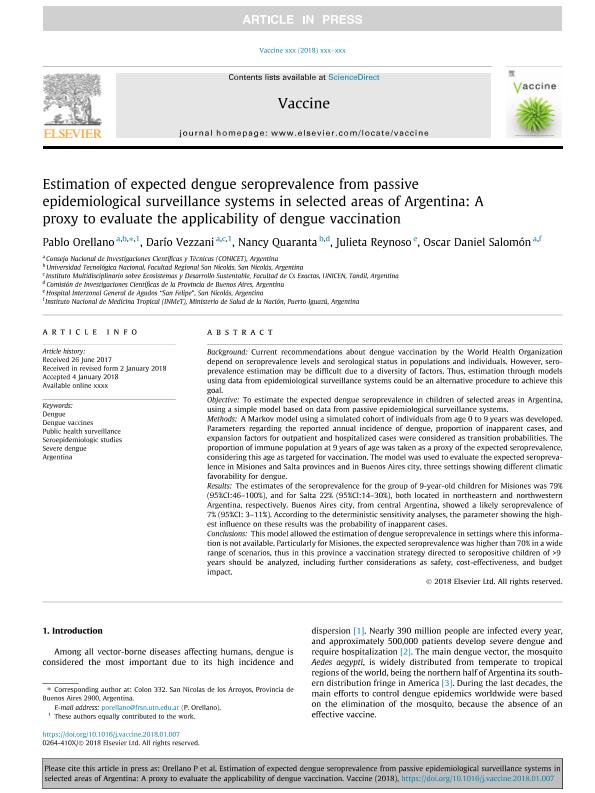Artículo
Estimation of expected dengue seroprevalence from passive epidemiological surveillance systems in selected areas of Argentina: A proxy to evaluate the applicability of dengue vaccination
Orellano, Pablo Wenceslao ; Vezzani, Dario
; Vezzani, Dario ; Quaranta, Nancy Esther; Reynoso, Julieta; Salomón, Oscar Daniel
; Quaranta, Nancy Esther; Reynoso, Julieta; Salomón, Oscar Daniel
 ; Vezzani, Dario
; Vezzani, Dario ; Quaranta, Nancy Esther; Reynoso, Julieta; Salomón, Oscar Daniel
; Quaranta, Nancy Esther; Reynoso, Julieta; Salomón, Oscar Daniel
Fecha de publicación:
02/2018
Editorial:
Elsevier
Revista:
Vaccine
ISSN:
0264-410X
Idioma:
Inglés
Tipo de recurso:
Artículo publicado
Clasificación temática:
Resumen
Background: Current recommendations about dengue vaccination by the World Health Organization depend on seroprevalence levels and serological status in populations and individuals. However, seroprevalence estimation may be difficult due to a diversity of factors. Thus, estimation through models using data from epidemiological surveillance systems could be an alternative procedure to achieve this goal. Objective: To estimate the expected dengue seroprevalence in children of selected areas in Argentina, using a simple model based on data from passive epidemiological surveillance systems. Methods: A Markov model using a simulated cohort of individuals from age 0 to 9 years was developed. Parameters regarding the reported annual incidence of dengue, proportion of inapparent cases, and expansion factors for outpatient and hospitalized cases were considered as transition probabilities. The proportion of immune population at 9 years of age was taken as a proxy of the expected seroprevalence, considering this age as targeted for vaccination. The model was used to evaluate the expected seroprevalence in Misiones and Salta provinces and in Buenos Aires city, three settings showing different climatic favorability for dengue. Results: The estimates of the seroprevalence for the group of 9-year-old children for Misiones was 79% (95%CI:46–100%), and for Salta 22% (95%CI:14–30%), both located in northeastern and northwestern Argentina, respectively. Buenos Aires city, from central Argentina, showed a likely seroprevalence of 7% (95%CI: 3–11%). According to the deterministic sensitivity analyses, the parameter showing the highest influence on these results was the probability of inapparent cases. Conclusions: This model allowed the estimation of dengue seroprevalence in settings where this information is not available. Particularly for Misiones, the expected seroprevalence was higher than 70% in a wide range of scenarios, thus in this province a vaccination strategy directed to seropositive children of >9 years should be analyzed, including further considerations as safety, cost-effectiveness, and budget impact.
Archivos asociados
Licencia
Identificadores
Colecciones
Articulos(CCT - NORDESTE)
Articulos de CTRO.CIENTIFICO TECNOL.CONICET - NORDESTE
Articulos de CTRO.CIENTIFICO TECNOL.CONICET - NORDESTE
Articulos(CCT - TANDIL)
Articulos de CTRO CIENTIFICO TECNOLOGICO CONICET - TANDIL
Articulos de CTRO CIENTIFICO TECNOLOGICO CONICET - TANDIL
Articulos(SEDE CENTRAL)
Articulos de SEDE CENTRAL
Articulos de SEDE CENTRAL
Citación
Orellano, Pablo Wenceslao; Vezzani, Dario; Quaranta, Nancy Esther; Reynoso, Julieta; Salomón, Oscar Daniel; Estimation of expected dengue seroprevalence from passive epidemiological surveillance systems in selected areas of Argentina: A proxy to evaluate the applicability of dengue vaccination; Elsevier; Vaccine; 36; 7; 2-2018; 979-985
Compartir
Altmétricas
Items relacionados
Mostrando titulos relacionados por título, autor y tema.
-
Capítulo de Libro Molecular Biology of Dengue VirusTítulo del libro: Dengue and Dengue Hemorrhagic FeverIglesias, Nestor Gabriel ; Byk, Laura Andrea ; Gamarnik, Andrea Vanesa - Otros responsables: Gubler, Duane J. Ooi, Eng Eong Kuno, Goro Vasudevan, Subhash Farrar, Jeremy - (Centre for Agricultural Bioscience International, 2014)
-
Orellano, Pablo Wenceslao ; Salomón, Oscar Daniel (Medicina (Buenos Aires), 2016-03)
-
Orellano, Pablo Wenceslao ; Reynoso, J.; Salomón, Oscar Daniel ; Vezzani, Dario (Elsevier, 2023-11)



